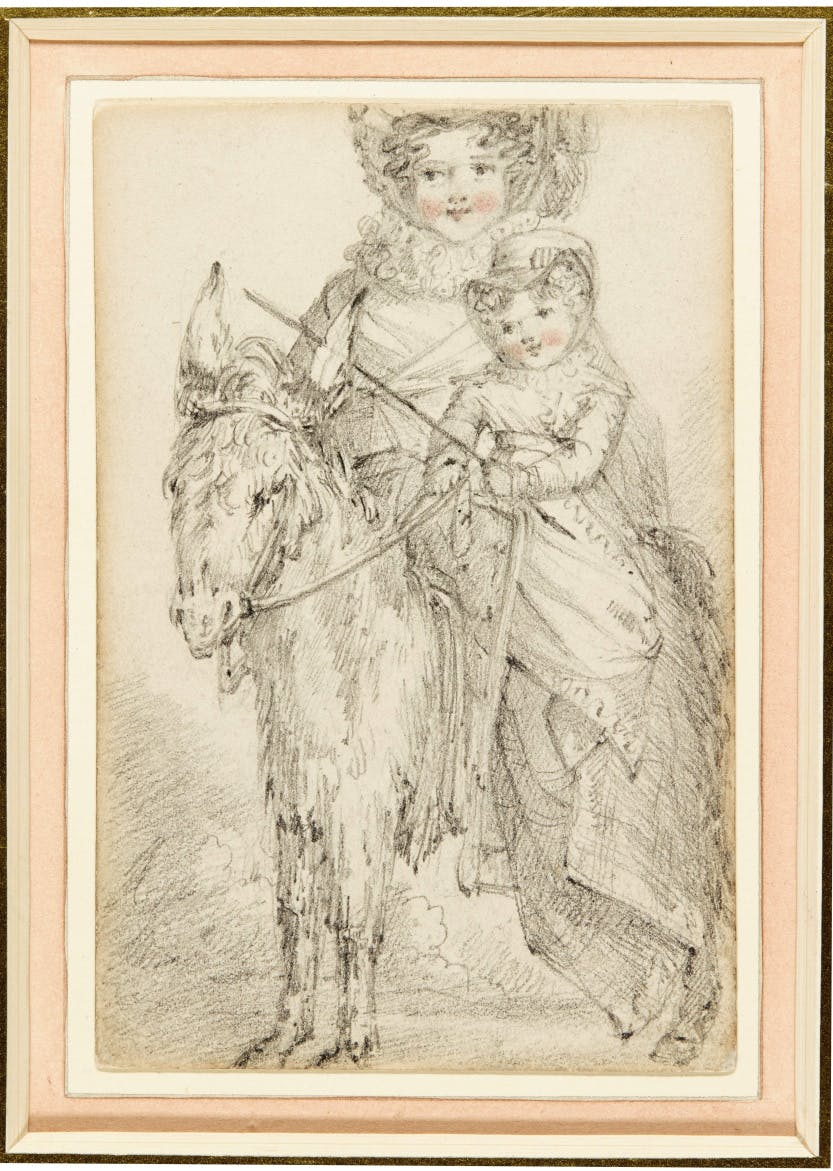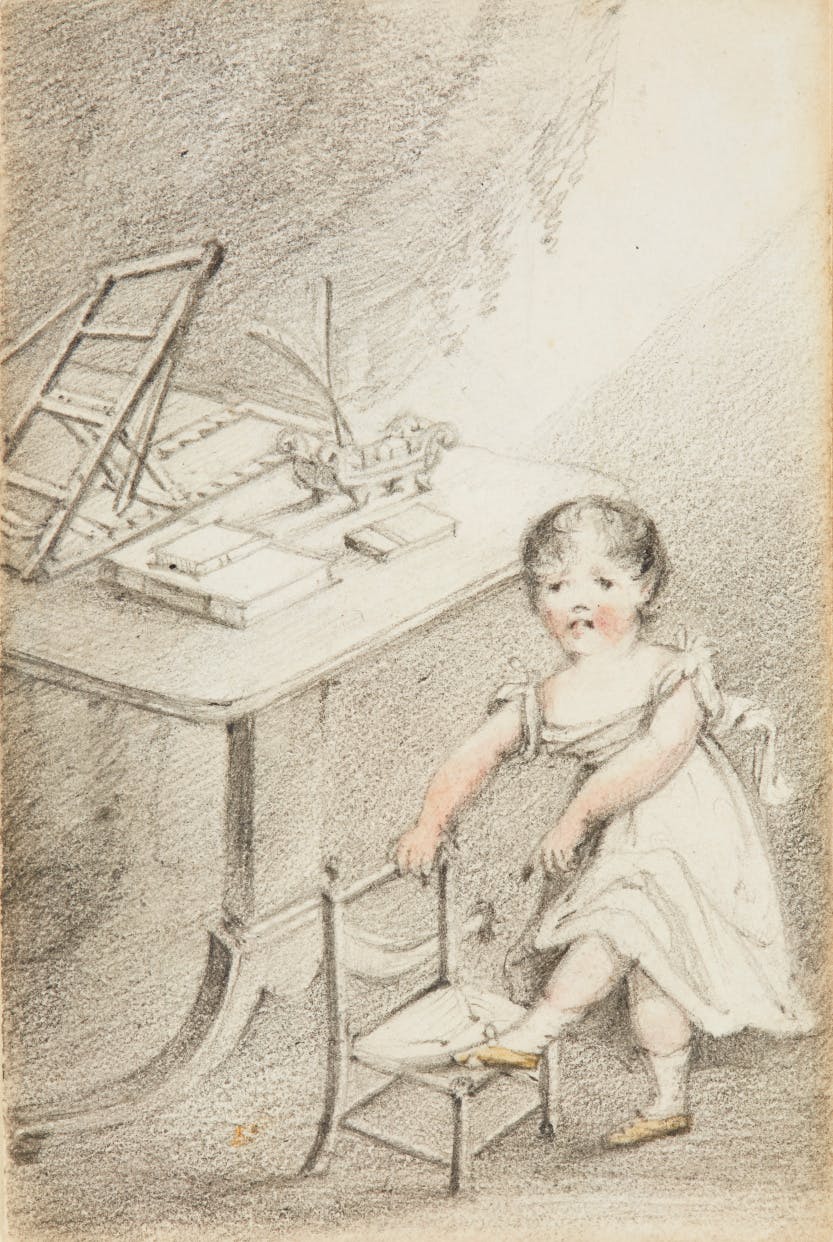Little Vickelchen': sketches of Queen Victoria as a girl
Date: 26 May 2019
Author:
Emma Shepley
As an old lady, Queen Victoria is an icon. Instantly recognisable, swathed in black, face grim-set from the burdens of monarchy, multiple childbirths, and grief.
However, the visitor route, called Victoria: A Royal Childhood, at Kensington Palace lets you experience a much less familiar Victoria. From her birth at the palace in 1819 to becoming Queen just 18 years later, the early portraits of Victoria on display across eight newly refurbished state rooms reveal a vivacious, energetic, and much-loved princess – her mother's adored 'little Vickelchen' and her Uncle Leopold's 'dear little chicken'.
Particularly eye-catching are a unique set of sketches showing Victoria at three years old, on holiday in the seaside town of Ramsgate, Kent in 1822. Four of the set of 12 portraits in the Historic Royal Palaces collection are on display for the first time since they were acquired in 2017. They give us a rare informal glimpse of Victoria as a pink-cheeked cherub and a bundle of energy.
In each portrait Victoria is centre-stage, playing with her ball, hoop, cards, spinning top, pull-along rabbit or pets - all the accessories of a secure middle-class childhood. She plays peek-a-boo, is held on a nursemaid's lap, rides a donkey on the beach, and in one delightful portrait pretends to ride on an over-turned chair. Only once is Victoria pouting and tearful, perhaps having hurt her foot which she points towards.
The drawings have exactly the same power and pull of adorable royal baby images today. These images don't just provide a sweet insight into Victoria's early childhood with her German mother Victoire, Duchess of Kent and her older half-sister, Princess Feodore of Leiningen, from her mother's first marriage. The shockingly unexpected death of Victoria's father Edward, Duke of Kent – fourth son of George III – when Victoria was eight months old was a tragedy from which this small family unit never recovered. The privileged and cossetted little girl seen playing was right in the middle of an almighty royal family power struggle.
Victoria's mother, the Duchess of Kent, was caught up in her late husband's debts and family disputes. She stayed on at Kensington Palace to ensure that their daughter was seen as English enough to take the throne if no more royal cousins closer in line were born. The latest Kensington Palace route displays this extraordinary story and the early rooms in particular set the surviving contents of this little girl's playroom against a background of dynastic wrangling and wicked uncles. The Duchess, Victoria, and Feodore regularly went on holiday to Kent throughout the 1820s and 1830s. They stayed in comfortably appointed residences: Albion House, Townley House, or West Cliffe House. Ramsgate had been popular for decades with well-to-do holiday-makers for the fashionable tonic of sea-bathing, delightfully captured by Benjamin West in 'The Bathing Place at Ramsgate' over 40 years before. Ramsgate gained the unique status of 'Royal harbour', bestowed by Victoria's 'Uncle-King' George IV in 1820, and a 16m sea front obelisk honouring George – nicknamed the 'Royal Toothpick' by unimpressed locals – was erected a few years later.
In 1844 a writer, in literary journal Fraser's Magazine for Town and Country, recalled sighting the little Princess on the 'noble sands of old Ramsgate'. He eulogises, '[the] belle Victoria, when she played with the pebbles and the tides' – a glimpse that indicates her early holidays were a time of playful freedom. In one portrait she sits with a basket of seashells overturned on the floor – clearly beach treasure. In the background, behind a wrought iron window frame, Ramsgate's distinctive waterfront and lighthouse can be seen. The viewpoint of this drawing probably places the holiday residence as the Albion House Hotel, (which still directly overlooks the harbour today).
In October 1822, Fife-born Lady Elizabeth Keith Heathcote (1781-1825) had joined the Kent family on their Ramsgate holiday. An aristocratic friend of the Duchess and a talented artist, Lady Elizabeth was accompanied by her step-daughter Anne, aged 10, and her own 2-year-old daughter Elizabeth Anne. The match between the two mothers, both with a toddler and older half-sister in tow, would undoubtedly have strengthened the friendship.
Lady Elizabeth was the eldest child of Elizabeth Dalrymple and Alexander Lindsay, Earl of Balcarres – the oldest peerage in Scotland. She is reputed to have taken lessons from Thomas Gainsborough, but as the artist died when Elizabeth was 7 years old – the lessons must have been limited or the story muddled. Lady Elizabeth married widower Richard Edensor Heathcote MP in 1815 after his first wife died in childbirth, taking on three children, but enduring her own loss when their first daughter died at two days old. Second child Elizabeth Anne was just the right age to play alongside Victoria in the sand.
Her drawings of Victoria are tiny, informal, and utterly charming. Backgrounds are loosely sketched, with details of tables, doors, cushions, books, pots, and pans. Victoria's indoor clothes are simple – always a white Empire line dress with puffed sleeves and shoes, sash and ribbons picked out in blue, red or ochre. She wears a red coral necklace that reappears in her more formal portrait by William Beechey.
Image: Sir William Beechey, ‘Victoria, Duchess of Kent with Princess Victoria’. Royal Collection Trust / © Her Majesty Queen Elizabeth II

Lady Elizabeth's step-daughter Anne may be the older girl, who teases Victoria in one drawing by holding up a rose for her to catch, but little more is known about her – the Heathcote family story ends abruptly. Just two years later, Anne died after a short illness aged 12 and Lady Elizabeth herself died the following year. The sketches stayed in the Heathcote family, passed to little Elizabeth Anne and then down to her daughter Adeline Edwards, who published them in 1897 in The Lady's Realm with Victoria's approval under the title 'A peep at the Queen in Infancy'. As a final family footnote, Elizabeth Anne's great grandson was Oswald Mosley, leader of the British Union of Fascists in the 1930s.
A postscript to Victoria's childhood holidays followed over 30 years later. The Queen fell in love with the painting 'Ramsgate Sands' by William Powell Frith while attending the Royal Academy exhibition of 1854. Albion House Hotel features prominently as the highest building overlooking the beach and the famous landmarks of Victoria's childhood are all there from the lighthouse to the donkeys lined up for rides. In the foreground, Frith has painted a little girl, held up by her nurse as she paddles in the sea. With happy memories stirred, Victoria bought the painting for Osbourne House – her seaside holiday home, where she carried on collecting shells on the beach with her own children.
Emma Shepley
Curator, Historic Royal Palaces
More from our blog

Prince Albert of Saxe-Coburg-Gotha: Monarchy's moderniser
26 August 2019
On the 200th birthday of Prince Albert of Saxe-Coburg-Gotha, Professor John R Davis argues that Albert's influence helped Queen Victoria rescue the British Monarchy.

Works of art on paper: a few stories behind the images
01 October 2019
With HRP’s collection of works of art on paper, people usually think that our collection is mostly made up of views of the palaces and fusty portraits of Kings and Queens, and often, that is largely what it is. But the truth about many objects is that even if they are quite mundane in themselves, it is the stories behind the image which makes these items so fascinating.

Restoring Genius: Grinling Gibbons's Carvings in the Orangery of Kensington Palace
30 July 2021
03 August marks the 300th anniversary of the death of Grinling Gibbons, the greatest woodcarver in British history. Buildings Curator Lee Prosser introduces us to some of his lesser-known but incredibly important works in the Orangery at Kensington Palace.




